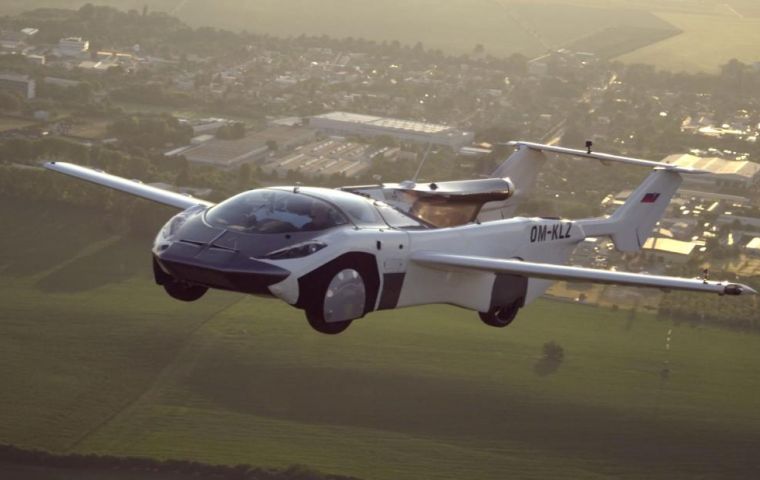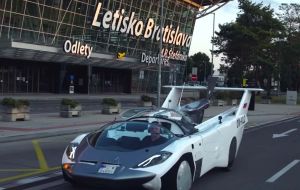MercoPress. South Atlantic News Agency
Flying car lands successfully in Slovakia
 In the air
In the air A Slovak-designed vehicle that can perform both as a car and an aeroplane completed an 80-kilometre stretch from Nitra to Bratislava and eventually left the airport into the streets of the country's capital.
The developers estimate the model will be available on the market by 2023. They named it AirCar.
The car can spread its wings in less than 3 minutes and become a single-engined aircraft with a propeller behind the cabin and fly at a speed between 170 and 190 km/h.
After the test flight, the prototype folded its wings and was driven into the streets of Bratislava with no problem.
The car-plane hybrid, designed by Slovak engineer Stefan Klein, was the first vehicle of its kind to land at Bratislava International Airport after completing the distance at an average of 170 kilometres per hour.
“This flight initiates a new era of dual transport vehicles. It opens a new category of transport and returns to the individual the freedom associated with cars,” Klein said.
“The machine worked perfectly,” he added.
“After landing, with the click of a button, the plane was transformed into a sports car in less than 3 minutes,” he went on.
The AirCar Prototype 1 is equipped with a 160 horsepower BMW engine with a fixed propeller and a parachute.
During the 40 hours of flight, the device has reached a height of about 2,500 meters and a speed of 190 kilometres per hour.
Four years ago, Klein introduced the Aeromobil 4.0 prototype, which differs from the AirCar not only in its design but also in how it transforms from an aeroplane into a normal vehicle, something that with the new model lasts less than three minutes.
The AirCar needs to have completed 50 hours of flight time to apply for certification. A second, faster prototype with light tweaks in the design and greater engine power, is said to be coming up.
Klein hopes to achieve the certificate of the European Aviation Safety Agency (EASA) with this improved model.
The AirCar runs on regular fuel. According to Klein, it can fly about 1,000 km at an altitude of 2,500 meters. It only takes 2 minutes and 15 seconds to transform into an aeroplane. The vehicle can carry two people, with a combined weight limit of 200 kg. But, unlike drone-taxi prototypes, it cannot take off and land vertically and requires a runway.
There are high expectations in the nascent flying car market, something that was long seen in popular culture as a milestone to be achieved. In 2019, consultant Morgan Stanley predicted that the sector could be worth $ 1.5 billion by 2040.
Hyundai Motors Europe CEO Michael Cole called the concept “part of our future.” It is considered a possible solution to the pressure on the existing transport infrastructures.
The company behind AirCar, Klein Vision, founded by Stefan Klein, says the prototype took about two years to develop and that it was invested “less than 2 million euros” (about $ 2.4 million).
Anton Rajac, an advisor and investor at Klein Vision, said that if the company could attract even a small percentage of global airline or taxi sales, it would be highly successful.





Top Comments
Disclaimer & comment rulesCommenting for this story is now closed.
If you have a Facebook account, become a fan and comment on our Facebook Page!